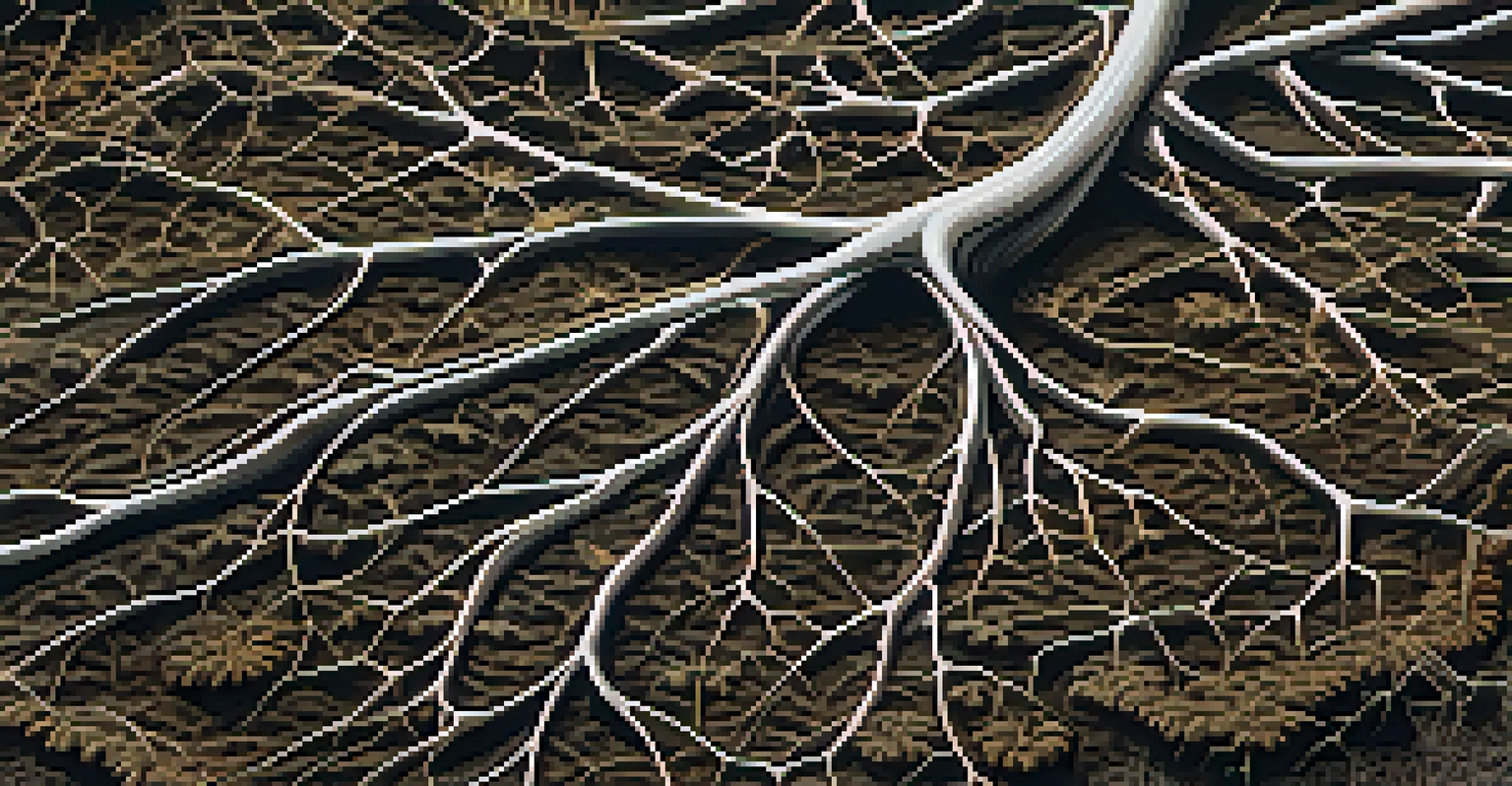Plant Communication: The Role of Mycorrhizal Networks Explained

What Are Mycorrhizal Networks?
Mycorrhizal networks, often referred to as the 'Wood Wide Web', are underground systems formed by fungi that connect the roots of plants. These networks facilitate nutrient exchange and communication between different plant species, creating a collaborative ecosystem. Imagine a bustling community where neighbors share resources, and you start to grasp the essence of these networks.
The health of our ecosystems is intimately tied to the hidden networks of fungi that connect and support our plant communities.
Fungi form symbiotic relationships with plant roots, allowing them to access essential nutrients like phosphorus and nitrogen. In return, plants provide fungi with carbohydrates produced through photosynthesis. This mutualistic relationship is fundamental to the health of many ecosystems, demonstrating how interconnected life truly is beneath the surface.
Research shows that these networks can help plants warn each other about pests or diseases. When one plant experiences stress, it can send chemical signals through the mycorrhizal network, alerting neighboring plants to bolster their defenses. This remarkable form of communication showcases the complex social structures that exist in nature.
The Role of Mycorrhizal Fungi in Ecosystems
Mycorrhizal fungi play a crucial role in enhancing soil structure and fertility. By forming hyphae, the fungal filaments, they create a network that binds soil particles together, improving water retention and nutrient availability. This process is akin to a spider weaving an intricate web that benefits the entire ecosystem.

Through their extensive networks, these fungi can also assist in carbon sequestration, helping to mitigate climate change. They capture and store carbon from the atmosphere, promoting healthier soil ecosystems while reducing greenhouse gases. In this way, mycorrhizal fungi serve as unsung heroes in the fight against environmental challenges.
Mycorrhizal Networks Foster Cooperation
These underground fungal systems enable plants to share nutrients and communicate, enhancing ecosystem resilience.
Moreover, mycorrhizal fungi can influence plant diversity within ecosystems. By connecting various plants, they allow for a greater exchange of resources, which can support a wider range of species. This biodiversity not only enhances ecosystem resilience but also contributes to a more vibrant and balanced environment.
How Plants Use Mycorrhizal Networks for Defense
Plants are surprisingly strategic when it comes to using mycorrhizal networks for defense. When a plant is attacked by pests, it can release specific chemicals into the network that signal other connected plants to prepare their defenses. It's like sending an urgent text message to friends, asking them to be on guard.
Nature does not hurry, yet everything is accomplished.
This communication allows neighboring plants to increase their production of protective compounds, such as toxins or repellents, even before they are directly attacked. Studies have shown that plants connected through these networks respond more effectively to threats than isolated plants. This proactive strategy can be the difference between survival and loss in a competitive environment.
Additionally, this form of communication can also indicate resource availability. If one plant discovers a nutrient-rich area, it can signal others via the mycorrhizal network, promoting a collective approach to resource utilization. Such cooperation enhances the resilience of the entire plant community.
The Impact of Environmental Changes on Mycorrhizal Networks
Environmental changes, such as climate change and habitat destruction, can significantly impact mycorrhizal networks. These changes can disrupt the delicate balance of interactions between plants and fungi, leading to diminished network efficiency. Imagine a city undergoing rapid development, where once interconnected neighborhoods become isolated.
For instance, increased temperatures and altered precipitation patterns can affect fungal growth and activity, potentially leading to reduced nutrient exchange for plants. This can result in weakened plants that are less capable of thriving under stress. Consequently, the entire ecosystem can suffer from these disruptions.
Environmental Changes Disrupt Networks
Climate change and habitat destruction threaten the efficiency of mycorrhizal networks, impacting plant health and biodiversity.
Furthermore, land-use changes, such as agriculture or urbanization, can sever these vital connections. When forests are cleared or soil is compacted, the mycorrhizal networks can be damaged, leading to decreased plant health and biodiversity. Maintaining healthy ecosystems requires understanding and protecting these critical underground networks.
Examples of Mycorrhizal Communication in Nature
One fascinating example of mycorrhizal communication occurs in forests, where trees can share resources through these networks. For instance, a larger tree may send nutrients to smaller, struggling saplings, ensuring their survival in tough conditions. This act of generosity reflects a deeper interconnectedness that fosters community resilience.
Another compelling case is that of the 'mother trees', which are older trees that play a pivotal role in supporting younger plants through their extensive mycorrhizal connections. Research has shown that these mother trees can prioritize resource distribution, ensuring that their offspring thrive. It's a heartwarming illustration of nurturing within the plant world.
Additionally, studies have observed that different plant species can communicate through the same mycorrhizal network. For instance, when sunflowers are attacked by aphids, they can signal nearby clover plants to bolster their defenses. This interspecies cooperation exemplifies the intricate social dynamics that exist in nature, revealing that communication transcends species boundaries.
Human Impact on Mycorrhizal Networks
Humans have a profound impact on mycorrhizal networks, both positively and negatively. Agricultural practices, such as monoculture, can disrupt these networks, reducing the diversity of fungi and impairing nutrient exchange. Think of it like a neighborhood where everyone has the same job—there's little variety and collaboration to support a thriving community.
Conversely, sustainable farming practices that promote biodiversity can enhance mycorrhizal networks. By planting cover crops and reducing chemical inputs, farmers can support healthier soil ecosystems that benefit from these vital fungal connections. This approach not only supports plant health but can also improve crop yields.
Human Actions Impact Mycorrhizal Health
Agricultural practices can either harm or help mycorrhizal networks, highlighting the importance of sustainable farming.
Education and awareness about the importance of mycorrhizal networks can empower individuals and communities to take action. By recognizing the value of these underground systems, we can advocate for practices that protect and restore them, ensuring that future generations can enjoy the benefits of a thriving ecosystem.
The Future of Mycorrhizal Research
As our understanding of mycorrhizal networks deepens, researchers are exploring innovative ways to harness their potential for agriculture and conservation. For instance, studies are investigating how to promote beneficial fungi in agricultural settings to enhance soil health and crop resilience. This research holds promise for creating more sustainable food systems.
Moreover, scientists are looking at the potential of mycorrhizal networks to restore degraded ecosystems. By reintroducing specific fungal species, we may be able to revitalize damaged landscapes and support plant recovery. This approach could be a game-changer in ecological restoration efforts.

The future of mycorrhizal research is bright, with ongoing studies revealing new insights into how these networks function and the roles they play in ecosystems. As we continue to learn more about the fascinating world of plant communication, we can better appreciate the intricate relationships that sustain life on Earth.